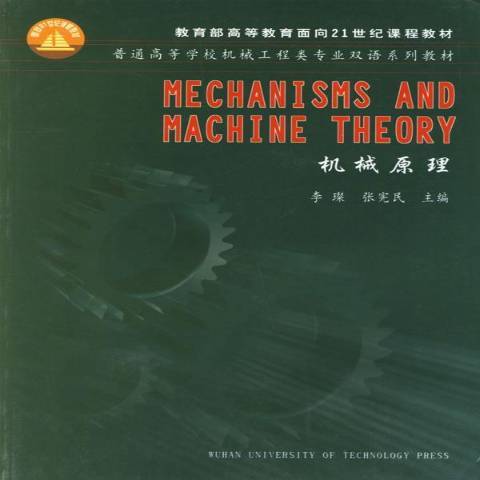《機械原理》是2004年武漢理工大學出版社出版的圖書。
基本介紹
- 中文名:機械原理
- 作者:張憲民
- 出版時間:2004年3月
- 出版社:武漢理工大學出版社
- ISBN:9787562920540
- 類別:機械學
- 裝幀:平裝

《機械原理》是2004年武漢理工大學出版社出版的圖書。
機械原理(theory of machines and mechanisms)研究機構和機器的學科,其主要組成部分為機構學與機械動力學。一般把機構和機器合稱為機械,因而機械原理研究的對象為機械。簡介機械原理研究機械中機構...
《機械原理》是由朱龍英、黃秀琴主編,高等教育出版社於2020年11月26日出版的“十三五”江蘇省高等學校重點教材。該書主要作為普通高等院校機械工程類專業的教學用書,也可作為近機械類和非機械類專業學生、科研人員及有關工程技術人員的參考...
《機械原理(雙色)》是2015年8月電子工業出版社出版的圖書,作者是李瑞琴。內容簡介 機械原理是高等院校機械類專業的一門主幹技術基礎課程,也是機構學學科知識和思維方法在機械類人才培養過程中的入門性課程。本書以培養學生的機械系統...
《機械原理(第八版)》是由西北工業大學機械原理與機械零件教研室編、高等教育出版社出版的“十二五”普通高等教育本科國家級規劃教材,可作為高等院校機械類專業的教材,也可供其他相關專業的師生及工程技術人員參考。全書共14章,內容包括...
機械原理是北京理工大學提供的慕課課程、國家精品線上開放課程、首批國家級一流本科課程。該課程授課教師為趙自強、孔凌嘉、張春林、王文中、孫娜、趙傑亮、朱朋哲等人,於2016年9月12日首次開課。截至2021年8月,據中國大學MOOC官網顯示,該...
《高等學校機械類系列教材·機械原理》是根據1992年國家教委批准的《高等學校工程專科機械原理教學基本要求》編寫的。全書除緒論外共十一章,包括機構的結構分析、平面機構的運動分析、平面機構的力分析及機械效率、平面連桿機構、凸輪機構、...
《機械原理》是2013年機械工業出版社出版的圖書,作者是張春林、趙自強。內容簡介 本書是按照高等工科教育逐步與國際教育接軌的要求編寫的改革創新型教材。全書內容從機構分析、機構設計、機構系統及運動方案設計到機械動力學,遵循以設計為...
《機械原理》是2012年7月16日清華大學出版社出版的圖書,作者是陸寧、樊江玲。內容簡介 陸寧、樊江玲主編的《機械原理(第2版)》根據機械原理教學基本要求編寫,內容包括平面機構的結構分析、機構的運動分析、連桿機構、凸輪機構、齒輪機構...
《機械原理(第九版)》是由西北工業大學機械原理與機械零件教研室編著,孫桓 、 葛文杰主編,高等教育出版社2021年出版的“十二五”普通高等教育本科國家級規劃教材。該可作為高等學校機械類專業的教材,也可供其他相關專業的師生及工程技術...
《機械原理》是2020年國防工業出版社出版的圖書,作者是安子軍。內容簡介 《機械原理(第4版)》是根據國家教育部機械基礎課程教學指導委員會批准的機械原理課程教學基本要求編寫的。全書由理論教學內容和實踐教學內容組成。理論教學內容共分...
《機械原理》是2016年機械工業出版社出版的圖書,作者是趙自強。內容簡介 本書是按照高等工科教育逐步與國際教育接軌的要求編寫的改革創新型教材。全書內容從機構分析、機構設計、機構系統及運動方案設計到機械動力學,遵循以設計為主線,以...
《機械原理》是2017年機械工業出版社出版的圖書。 這本《機械原理》由馮立艷主編,根據“教育部高等學校機械基礎課程 教學指導分委員會機械原理課指組”2009年制訂的“機械原理課程教學基本 要求”,融合多年來的教學實踐經驗,由長期擔任...
《機械原理(朱龍英)》是2011年西安電子科技大學出版社出版的圖書,作者是朱龍英。內容簡介 本書是根據教育部機械基礎課程教學指導委員會批准的機械原理課程教學基本要求編寫的。全書以培養學生創新意識和機械系統方案設計能力為目標,以設計為...
《機械原理》是2006年高等教育出版社出版的圖書,作者是張春林。內容簡介 《機械原理(附光碟)》分為緒論篇、機構的組成與分析篇、基本機構及其設計篇、機構組合系統及其設計篇和機械系統動力學篇。緒論中主要講述機械、機器、機構的基本...
《機械原理》是2013年8月機械工業出版社出版的圖書。內容簡介 本書詳細闡述了機構學中常用機構的工作原理、分析及設計方法。本書紙質版本按照內容可分為分析篇、設計篇和附錄。分析篇包括常用機構、機構的結構和運動分析、機械系統靜力學和...
《機械原理》是2015年出版的圖書,作者是安子軍。內容簡介 本書是根據國家教育部機械基礎課程教學指導委員會批准的機械原理課程教學基本要求編寫的。全書由理論教學內容和實踐教學內容組成。理論教學內容共分13 章,包括緒論、平面機構的結構...
《機械原理》是2021年華中科技大學出版社出版的圖書。內容簡介 本書以機械類專業的學生為對象,著重培養學生的創新能力、機械系統方案設計能力;以機構系統運動方案設計為主線,重點討論連桿機構、齒輪機構、凸輪機構、間歇機構等常用機構設計...
《機械原理》是2019年中國電力出版社出版的圖書。內容簡介 全書共分11章,內容包括緒論、平面機構的結構分析、平面機構的運動分析、平面機構的力分析、平面連桿機構及其設計、凸輪機構及其設計、齒輪機構及其設計、齒輪系的傳動比計算、其他...
《機械原理》是2009年國防工業出版社出版的圖書。內容簡介 全書由理論教學內容和實踐教學內容組成。理論教學內容共分13章,包括緒論、平面機構的結構分析、平面機構的運動分析和力分析、機械中的摩擦和機械效率、平面連桿機構、凸輪機構、齒輪...
《機械原理》是科學出版社出版圖書,是普通高等教育機械類國家級特色專業系列規劃教材。本書根據教育部高等學校機械基礎課程教學指導分委員會制定的《機械原理課程教學基本要求》和《機械原理課程教學改革建議》,並結合近年來教學改革實踐的...
《機械原理》是2019年中南大學出版社出版的圖書。內容簡介 《機械原理(第三版)/普通高等教育“十二五”規劃“網際網路+”精品教材》根據教育部高等學校教學指導委員會機械基礎課程教學指導分委員會新制定的《高等學校機械原理課程教學基本要求...
《機械原理》是2020年機械工業出版社出版的圖書。內容簡介 本書是在台灣學者顏鴻森、吳隆庸先生所著《機構學》第4版的基礎上整理而成的簡體中文版。原著是作者基於30年來在國內外大學、研究機構和工業界教學、研究、服務的經驗,在考慮...
《機械原理》是2011年出版的圖書,作者是王德倫。內容簡介 全書由上、中、下三篇組成,上篇為機械系統運動方案設計,主要介紹機構及其套用、常見機構類型及套用特點、機構組成原理及其演化變異、機構再生運動鏈設計法(顏鴻森機構創造技法)、...
《機械原理》是2011年北京大學出版社出版的圖書。內容簡介 本書是根據國家教育委員會的“高等工業學校機械原理課程教學基本要求”而編寫的。本書主要研究機構的組成原理、機構運動學、機器動力學、各種機器中常用機構的運動及動力性能分析與...
《機械原理》是1997年高等教育出版社出版的圖書,作者是鄭文緯、吳克堅。本書主要講述了包括機構的結構分析、平面機構的運動分析、平面連桿機構及其設計、凸輪機構及其設計、齒輪機構及其設計、輪系及其設計等內容。內容簡介 本書是在前六版的...
《機械原理》是2009年機械工業出版社出版的圖書。本第2版包括正文12章和附錄,內容分別為緒論、機構的結構分析、平面連桿機構、凸輪機構、齒輪機構、輪系、步進機構、機器人機構、其他機構、機械運動動力學方程、機械的平衡、機械運動方案...
《機械原理》是2014年重慶大學出版社出版的圖書。內容簡介 機械原理是機械類專業培養計畫中的主幹專業技 術基礎課程,對培養學生掌握現代機器分析和設計理 論、機械產品創新思維和設計能力具有重要作用。張 東生編著的《機械原理(機械設計...
《機械原理》是作者朱理 編,2004年高等教育出版社出版的圖書。內容簡介 《機械原理》是教育科學“十五”國家規劃課題之一——“21世紀中國高等學校套用型人才培養體系的創新與實踐”課題的研究成果。《機械原理》對機械原理課程傳統教材的...
機械原理課程是西北工業大學建設的慕課、國家精品線上開放課程、首批國家級一流本科課程。該課程於2014年10月08日首次在中國大學MOOC開課,授課教師是葛文杰、張永紅等人。據2021年8月中國大學MOOC官網顯示,該課程已經開課14次。該課程共...
《機械原理》分為機構的結構及分類、機構運動學、機構動力學和機械系統運動方案設計四大部分,這種編排使知識體系更適合學生學習,也使內容更緊湊。其中第一部分主要介紹機構的結構、組成和分類,增加了對液動與氣動機構、磁力機械、微動機械...
